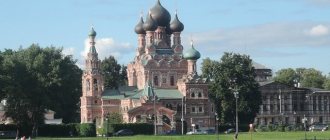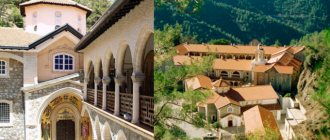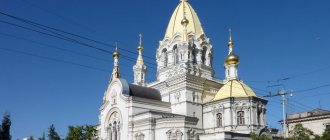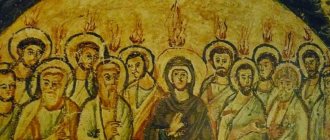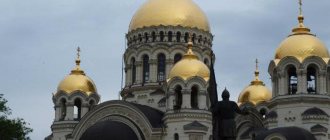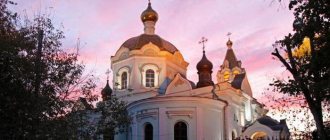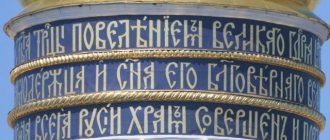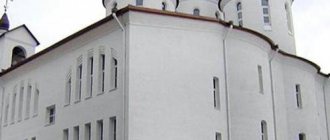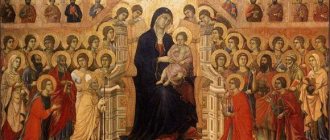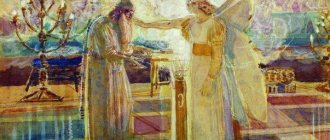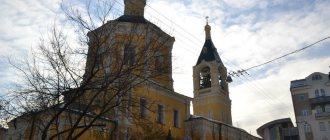Most architectural monuments are directly related to various important events. The Tithe Church in Kyiv is the first Christian temple of ancient Rus', made of stone. The Cathedral of the Blessed Virgin Mary was built shortly after the baptism of Prince Vladimir. The structure was the largest and most majestic at that time.
Description of an architectural masterpiece
For the construction of the Tithe Church, Prince Vladimir invited the best craftsmen from Byzantium. Along with them came the fashion for imitation of Byzantine churches, that is, for the construction of cross-domed buildings. The six-tier cathedral was decorated with 5 domes, as well as galleries on 3 sides, which contained various rooms.
During excavations of the first stone church in Rus', archaeologists found elements that indicated a rather rich interior decoration. For example, these include:
- Parts of frescoes.
- Pieces of marble.
- Individual mosaic elements.
- Jasper.
- Porphyry.
- Valuable wood species.
Inside the church there was a large number of ancient icons, crosses, as well as vessels from Chersonesos. As a gift, Vladimir donated the relics of St. Clement, the Christian great martyr and preacher of the 1st century AD. e.
The Decimal Church is also called the Church of the Assumption of the Blessed Virgin Mary (official name). The monastery is mentioned in various ancient documents, manuscripts and archives. Despite the huge number of different sources, none of them show the appearance of the church, so we can only guess what it was like based on archaeological finds. Most historians and archaeologists believe that the Church of the Assumption of the Blessed Virgin Mary (989−996) was fully consistent with the architectural views of Byzantine masters.
Scientists also suggest that next to the main building there were chambers of the Kyiv nobility, as well as the prince’s palace. Quite close there was an international market, which was located on a square called Babi Torzhok.
Interesting facts and theories
Now there are several interesting theories that are associated with the church. One of them talks about the cathedral as a symbol of the Orthodox world. If you believe these sources, at that time the holy church building was of utmost importance and occupied a special place in the culture of the ancient Slavs.
It was located on the Kyiv mountain, from where Podol, Lukyanovka, the Left Bank, Lviv Square, as well as other interesting places in modern Kyiv were clearly visible.
It is known for sure that the Church of the Tithes was dedicated to the Most Holy Theotokos, but it is impossible to say the date of death (Assumption) or birth (Christmas). The name Desyatinnaya appeared due to the fact that the prince spent a tenth of all income on its construction and maintenance.
Other interesting facts:
- People called the Church of the Holy Mother of God “marble.” The thing is that the facades were covered with numerous marble elements, and the floors were covered with geometric patterns from individual multi-colored marble pieces.
- The cathedral was founded “on the blood” of Russian martyrs. The first were John and his father Fedor. It was a family burial.
- The Tithe Church became the last refuge for Prince Vladimir and his wife Anna. The miraculous relics of Princess Olga were also placed here.
- Peter Mogila planted a linden tree in memory of the revival of the church. It is still growing to this day.
Most historians are confident that the first stone church is a monumental structure that contributed to the development of the Christian religion. This was the beginning of a massive transition from paganism to Orthodoxy.
Architecture of Ancient Rus'
Old Russian architecture, which developed over eight centuries, went through a difficult path from wooden buildings to monumental white-stone churches. They served as a stronghold and reliable refuge in difficult historical eras.
It was ancient Russian architecture that was the real embodiment of the power of the state and its highest spiritual culture.
The architecture of Ancient Rus' is a unique phenomenon in the history of architecture. Despite the power of the stone forms and the often fortress-like nature of the white stone monoliths, it cannot but amaze with its beauty.
Perhaps, now these are the only buildings that make you feel the aroma of long-gone centuries with epic heroes and barbarian tribes of the Mongol-Tatars. But the path to white stone architecture was very difficult and long. And it began with a wooden hut.
Not every resident of a modern metropolis has been to a real Russian hut.
Most of the old villages are irrevocably a thing of the past, while some, on the contrary, are being built up with mansions, sometimes in neo-Russian style: many do not want to part with the spirit of antiquity.
If we talk about the design of a real Russian hut, then it is a wooden log house (or two log houses), covered with a gable roof, or less often with a hipped roof. Four logs, folded into a rectangle, were connected at the corners of the house using notches, forming a crown.
There were two types of cuttings: “in the oblo” (“in the bowl”), which is found in very old buildings and village huts, and “in the paw” - more complex than the first, but more economical. The crowns were superimposed on each other, and a log house was obtained. To build large buildings, several log houses were connected.
Log houses were often decorated, especially in the north, with carvings. Window frames, shutters, gates—their lace wooden ornaments included fancy figures of fantastic creatures. The hut became very elegant!
Cutting corners “into the edge” also has another name – “into the bowl”.
“Obly” in ancient times meant “round.” This connection of logs is considered the most ancient. The basis of the cut was a round bowl carved into a log. This recess was directed upward. A transverse log was placed into it. The option of cutting corners, when the logs are cut straight from the ends (without any residue), is called “in the paw”.
Most of the wooden houses with which ancient Russian cities were built were not much different from a peasant hut.
Some houses were built two-story, many were placed on a basement - a semi-basement floor that served for household purposes.
In a simple one-story wooden house, in addition to the main room - the upper room - there was also an additional room - living room. And adjacent to the log house was a vestibule—the entrance part of the house.
It’s interesting that now we almost never use the word “canopy”. But in everyday life the French version is the lobby!
A large stove was placed in the center of the hut, which heated the entire building and was called Russian. Everything depended on her - both warmth and human well-being.
Construction technology
It is generally accepted that the temple used to be of impressive size. At the same time, it acted as the compositional center of the entire city.
The structure was built using Byzantine technology. Its main principle is to cover the free space of the building with vaults.
Certain nuances, for example, the materials used, the brickwork of the foundation, suggest that the most skilled Byzantine craftsmen were involved in the construction. Also, some bricks have Cyrillic letters on them, which may indicate the participation of the South Slavs in the construction. Historians consider the Bulgarians the most likely candidates.
Unfortunately, nothing remains of the majestic temple, only a picture. Scientists were only able to find small parts of the foundation of this church.
Historical information about the origin
The main historical document, called “The Tale of Bygone Years,” briefly states that Prince Vladimir decided to build the Church of the Blessed Virgin Mary in 989. No one can say exactly when construction began and why it was named that way, but all historians take the year 990 or 991 as a basis. In 996 the consecration of the new church took place. Some evidence indicates that the cathedral was erected on the site where the pagans executed the first martyrs John and Theodore.
40 years later, Prince Yaroslav the Wise built the Hagia Sophia or St. Sophia Cathedral, which is why the importance of the Tithe Church decreased significantly. There is practically no information about her further fate. There is confirmation of the attack:
- Prince Mstislav Andreevich plundered the temple in 1169.
- Rurik Rostislavovich did the same in 1203.
The church barely survived the earthquake, perestroika and fire. Complete destruction occurred after the attack by the army of Batu Khan during the siege of Kyiv in 1240. City residents hid in the cathedral in search of salvation from enemy troops. The walls of the structure could not withstand the onslaught of battering guns and fell, burying everyone who was inside.
In addition to its main purpose, the temple was used as a tomb. On its territory rested the relics of Clement, Anna, Vladimir and Olga, who were transferred later.
After some time, the prince’s remains were hidden, but for some unknown reason they were lost and never returned to the tomb. Their whereabouts are still unknown.
Surviving autographs of the Kyiv princes
St. Sophia Cathedral is also unique in that you can see the autographs of the Kyiv princes in it, according to archaeologists. And these are not signatures on state acts, but prayer requests inscribed on temple walls. At this point, the autographs of Princess Olisawa and her son, Prince Svyatopolk II of Kyiv, have been identified. You can also read a separate article about this on our portal.
The further fate of the church
They tried to revive the Tithe Church several times. The first attempt was made by Peter Mogila at the beginning of the 17th century. He began to clean the walls and foundation of the temple, and also erected a small church in the name of the Nativity of the Blessed Virgin Mary. For this purpose, preserved old walls were used. Inside the building, the Metropolitan placed an icon of St. Nicholas, which Prince Vladimir brought from Chersonesos. After his death, Peter Mogila bequeathed a whole thousand gold pieces for the restoration of the ancient cathedral.
Interest was renewed in the 19th century. During excavations and other archaeological research, parts of mosaics, foundations and frescoes were discovered. They decided to restore the cathedral, so the famous architect Vasily Stasov was invited from St. Petersburg to Kyiv. The new construction took 14 years and 100 thousand gold rubles. The reconstructed church was illuminated in 1842.
She was quite different from her predecessor. It was built in the Byzantine-Russian style. The structure was a square, each side of which was almost 30 m long, which is 2 times smaller than the temple of Vladimir. Stasov's Church was destroyed by the communists in 1928, since under Soviet rule it was subject to mandatory demolition , like most other cultural monuments. Already in 1936, the foundation of the cathedral was completely dismantled. Because of this, the monumental structure has not survived to this day.
Saint Sophia Cathedral. The only surviving ancient Russian temple with Byzantine mosaics
Mosaic finishing is a rather complex and expensive technique. But the Kyiv princes tried to equal the Byzantine emperors, and therefore a number of capital churches, like Byzantine ones, were decorated with mosaics. Alas, only one such temple has survived to this day - the Cathedral of St. Sofia. Of course, other churches in the city were also decorated with mosaics: the already mentioned Church of the Tithes, the Assumption Cathedral of the Kiev Pechersk Lavra and St. Michael’s Golden-Domed Cathedral. But almost nothing remains of these decorations. Only some of the mosaics of St. Michael's Golden-Domed Cathedral were preserved, and now they can be seen in the choirs of St. Sophia Cathedral and in the Tretyakov Gallery in Moscow. But in the St. Sophia Cathedral all the mosaics are in their place. See our special material about this.
Construction of a new modern temple
The Marble Church is a huge and quite functional structure. During construction, expensive building materials were used, such as granite, quartzite and rare woods. The binding material was cement - the name given to a solution of carefully diluted lime and crushed ceramics.
With its help it was possible to build quite large and reliable buildings.
In 1996, 2 collectible coins with the image of the cathedral were issued. One of them was made of pure silver, and the other was made of an alloy of copper and nickel. Below is the inscription “Spiritual Values of Ukraine”. Photos of these coins are in school textbooks on the history of Ukraine.
The destruction of the Church of the Blessed Virgin Mary can be called a real tragedy for a huge number of believers, historians and simply lovers of majestic architecture. Thanks to the cooperation of people, in 2006 a temple-tabernacle was erected on the site of the ruins. But the construction was illegal , so many disputes and scandals arose.
Ultimately, in 2007, they decided to destroy the new church, and in its place a small wooden temple was built. In the same year, the building was consecrated by His Beatitude Metropolitan Vladimir.
In 2009, a monastery was created in the courtyard of the new temple. Already next year they wanted to build another cathedral, which would be as similar as possible to the Church of the Tithes of Prince Vladimir. The layout and design had already been developed, but local officials never approved the idea.
It is quite difficult to overestimate the importance of creating such a structure during the time of Prince Vladimir. The construction of this church changed the architectural traditions of Rus', and also contributed to the strengthening of the Christian faith in the state.
